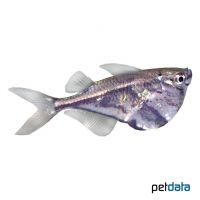Marbled Hatchetfish (Carnegiella strigata)
| Marbled Hatchetfish Carnegiella strigata | |
|---|---|
| Name | Marbled Hatchetfish |
| Name Lat. | Carnegiella strigata |
| Synonym | Gasteropelecus strigatus |
| Family | Freshwater Hatchetfishes |
| Family lat. | Gasteropelecidae |
| Order | Characins |
| Order lat. | Characiformes |
| Origin | South America |
| Habitat | Tributaries, forest streams |
| Diet | Carnivore |
| pH | 4.0-7.0 |
| Behavior | Peaceful |
| Keeping | Group |
| Care Level | Moderate |
| Reproduction | Egg scatterer |
| Breeding | Moderately difficult |
| Life Span | 3-5 years |
| Protection | No |
| Metric Units | |
| Size | 4 cm |
| Temperature | 20-28 °C |
| Hardness | 1-10 °dH |
| Aquarium | 100 l |
| US Units | |
| Size | 1.6" |
| Temperature | 68-82 °F |
| Hardness | 18-178 ppm |
| Aquarium | 25 gal |
Distribution and habitat
Marbled hatchetfish are widely distributed in herbaceous waters of Colombia, Peru, Brazil, Guyana and Suriname. They live in loose schools in forest streams and rivers, preferably in places with rich vegetation on the water surface.
Maintenance
The aquarium should have plants flooding to the water surface, stones and roots, as well as floating plants that serve as hiding places and dim the light. The soft, slightly acidic water should have a weak current. A gapless cover is necessary, because the jumpy animals can jump.
No ammonia, ammonium and nitrite should be detectable, the nitrate value should not exceed 100 mg/l. To ensure the water quality and oxygen content, a filter and heater adapted to the aquarium size is required, as well as lighting for the species-appropriate day-night rhythm of the animals.
Diet
They prefer to eat food from the water surface. The food supply consists of small insects such as mosquitoes, aphids, fruit and fruit flies, plus cyclops, daphnia and mosquito larvae, which are also well accepted freeze-dried or frozen. After habituation, high-quality dry food (flakes, granules) is also accepted.
Regular and varied feeding avoids deficiency symptoms. Only feed as much as is eaten immediately (in a maximum of 10 minutes).
Behaviour and compatibility
They are peaceful, somewhat skittish fish and can be kept very well in a community tank with other peaceful and calm fish. At least 5, but preferably more Marble Hatchetfish should be kept together.
Basically, only mutually compatible fish species with similar demands on water conditions and water temperature should be socialized.
Sex dimorphism
The sexes can only be identified by the spawning of the female.
Reproduction and breeding
In soft, slightly acidic peat water, they spawn near the surface between fine-feathered plants and the roots of floating plants. If the path of the eggs as they sink is too long, they are eaten by the adults. The larvae hatch after about 30-36 hours and swim freely from the 5th day.
Fry must be fed several times a day with special rearing food (dust food). In a community tank breeding is hardly possible, because the spawn is easy prey.
Important
They have powerful pectoral fin muscles which allow them to take off quickly from the water when fleeing and, propelled by quick strokes with their tail fin, they can fly up to 3 meters.
The well-being of the fish should be monitored regularly. Temperature should be checked daily, pH, hardness and nitrate levels at least fortnightly. Regular partial water changes are recommended, even if the pollutant level has not yet reached the upper limit. Sudden changes in water quality should be avoided. Newly introduced fish must be accustomed slowly to the water in the aquarium.
Further literature can be found in your pet store.
References
Text: petdata; Image: petdata
Source: BMELV (1998): Tierschutzgutachten - Haltung von Zierfischen (Süßwasser); RIEHL & BAENSCH (2006): Aquarien Atlas Bd. 1, Mergus Verlag; ENGELMANN (2005): Zootierhaltung - Tiere in menschlicher Obhut: Fische, Verlag Harri Deutsch
- Gemäß § 21 Abs. 5 Tierschutzgesetz idgF
